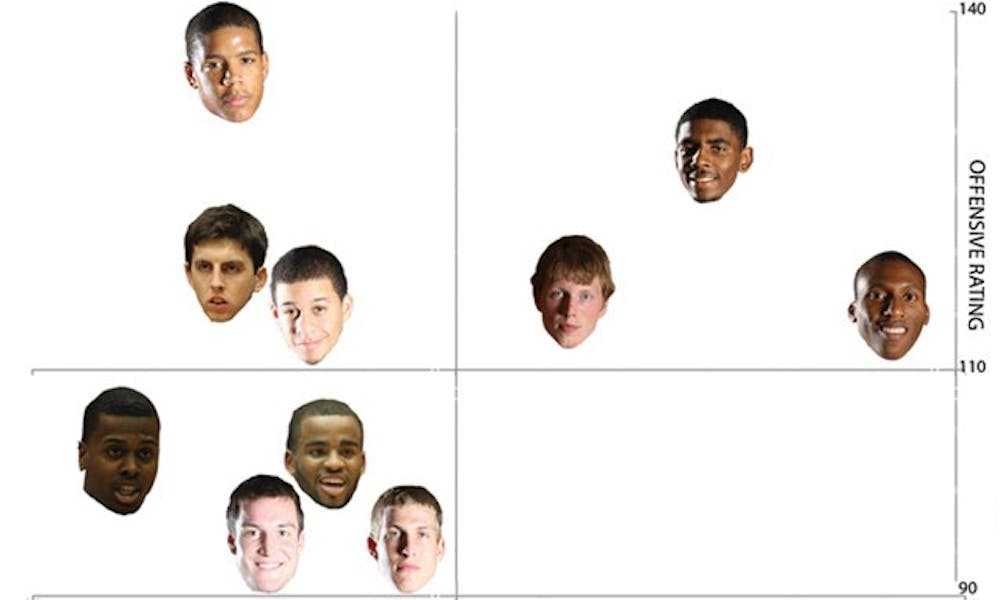The beginning of 2011 hasn’t been especially kind to Mike Krzyzewski and his team. The Blue Devils won a dogfight against Maryland in Cameron, then lost to Florida State on the road, and looked lost for nearly 30 minutes against Virginia.
But perhaps some simple New Year’s resolutions will help Duke get back to its former No. 1 ranking. Using some basic statistics, it’s not hard to identify some goals that might help the Blue Devils as the calendar moves toward March.
The first number we’ll use is “offensive rating.” It takes into account many different ways players contribute to scoring, from made field goals to offensive rebounds to turnovers—and it spits out one number that expresses how much offense a player generates per possession.
Because it’s a per possession stat, though, offensive rating doesn’t mean much on its own. Instead, the key to offensive stardom in basketball is combining a high offensive rating with a high usage rate, which measures the percentage of a team’s possessions that end with the ball in the hands of a particular player, because that player shoots or turns the ball over. So the best players are the ones who not only have a high offensive rating, but who are involved often enough to have a high usage rate.
Here, then, is a chart to illustrate the relationship between these two statistics—usage and offensive rating—for each Blue Devil player:
So, what does this show us?
The top-right quadrant shows the offensive stars: high efficiency and high usage. These players are good scorers, and are very involved in the offense.
Move to the top left, and you’re looking at the players with the most to gain from resolving to get more involved in the offense. These are the guys with the greatest potential to become bigger cogs in the offensive machine.
In the bottom left, we find the team’s “role players,” who don’t score particularly efficiently, but who also aren’t playing outside themselves and aren’t using lots of possessions.
The final quadrant, on the bottom right, gives a testament to head coach Mike Krzyzewski, in that no players appear here, which is where the low-efficiency, high-usage players would show up. These are players who aren’t especially good scorers but who nonetheless use lots of the team’s possessions. Krzyzewski’s players know their roles so well that no one is trying to score more than he’s able to.
This gives a picture of where things stand, but in making resolutions, it’s critical to look at what could improve. Here are four players that could really benefit themselves and their team by improving a certain area of their game.
1. Mason Plumlee: Work on free throw shooting until blue in the face. It’s no surprise to see rookies Josh Hairston and Tyler Thornton in the “role player” quadrant; nor is it odd that workmanlike junior Miles Plumlee is down there. But Mason has started 12 of 17 games and has been counted on to fill a scoring role in the paint. Mason is a monster on the defensive glass, and a good offensive rebounder as well, but his efficiency is held down by his dismal 42.2 percent performance at the charity stripe. Better finishing inside and more made free throws would turn Plumlee into a reliable offensive threat.
2. Andre Dawkins: Keep looking for your shot. Dawkins’s offensive rating currently ranks 13th in the country, as he’s absolutely shooting lights out: 47.7 percent from beyond the arc, 68.6 percent on two-point shots, and over 80 percent from the line. It’s icing on the cake that he rarely turns the ball over (just 15 turnovers in 441 minutes). But in spite of that productivity, his usage rate ranks second-to-last on the team, ahead of only Thornton. His role has increased since Kyrie Irving got hurt, and his performance on Saturday against Virginia showed that he’s ready to take more of a leadership role for his team. It’s impossible to expect Dawkins to keep making shots at such high rates, but if he can resolve to keep on shooting, he’ll be a massive asset on offense.
3. Seth Curry: Get to the rim more and finish better. Curry’s making better than 40 percent of his shots from beyond the arc, and he’s an 85 percent marksman from the free-throw line. He’s been effective bringing the ball up (30 assists to 16 turnovers) and he’s been a pesky defender, tied for the team lead with 24 steals. His Achilles’ heel, though, is two-point shooting: He’s made just 14 of his 43 two-point attempts (32.6 percent). If he can improve that number, he could earn his way into the starting lineup at point guard.
4. Ryan Kelly: Fill the void Duke has as an inside scoring threat. Kelly is nowhere near the rebounder that fellow sophomore Mason Plumlee is, but he’s blocked just four less shots despite playing 127 less minutes. On offense, though, he shoots better near the rim (56 percent from two-point range compared to Mason’s 55 percent) but adds a three-point threat (32 percent despite a recent shooting slump) and a good free-throw stroke at 86.7 percent. If Plumlee doesn’t step up to become the inside scoring threat many have expected him to be, perhaps Kelly can inherit that role.
These four have shown serious potential and could improve their games with a few of these adjustments. Duke will get a boost if they make good on its New Year’s resolutions.
Get The Chronicle straight to your inbox
Signup for our weekly newsletter. Cancel at any time.

